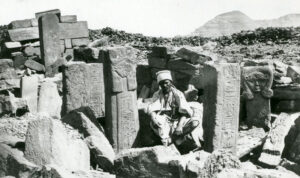Jerusalem Holy Sites
By Jennifer Bartlett
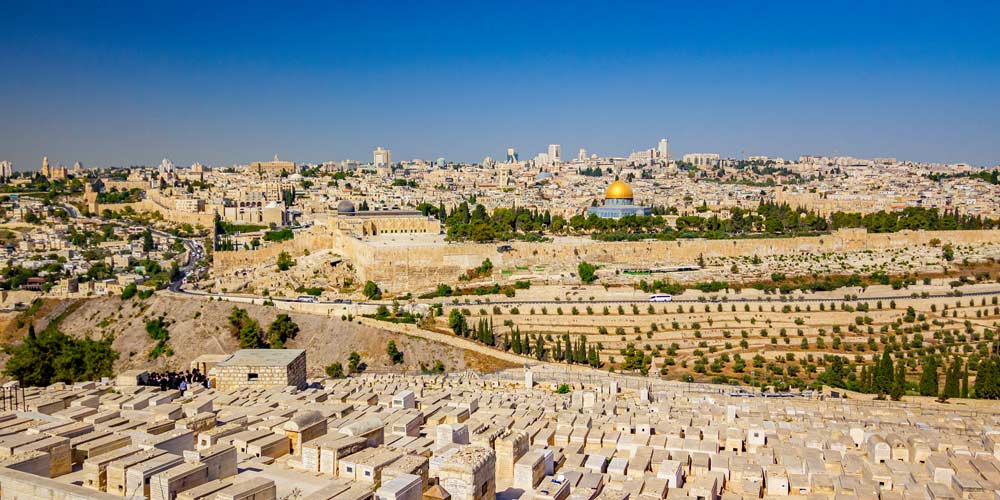
A Christian tour of Israel would not be complete without a walk through Jerusalem holy sites in the footsteps of Jesus. It is a profound experience for people who believe the Word of God is true. Jerusalem is a city rich with the foundations of our faith, where Bible figures walked and where our Christ was crucified and rose from the dead. There is something powerful about walking the steps that Jesus walked and seeing the sites mentioned in the Bible. From the Temple Mount to the Garden of Gethsemane to the place where Jesus ascended into heaven, there is so much to see.
Old City Jerusalem Holy Sites
The Temple Mount
The Temple Mount is believed by many to be where the Jewish temple once stood. After the destruction of Solomon’s temple in 586 BC, the temple was rebuilt by Zerubbabel, and later embellished by Herod the Great. It was this temple where Jesus was presented to God by his parents, according to Mosaic Law (Luke 2:22-24) and where He engaged in discussion with the teachers of the Law at the age of 12 (Luke 2:41-47). Here, too, He overturned the tables of those charging exorbitant prices for sacrificial animals in His zeal for the house of God (Matt. 21:12; Jn. 2:14-17), and here He regularly taught the deep truths of God for all to hear.
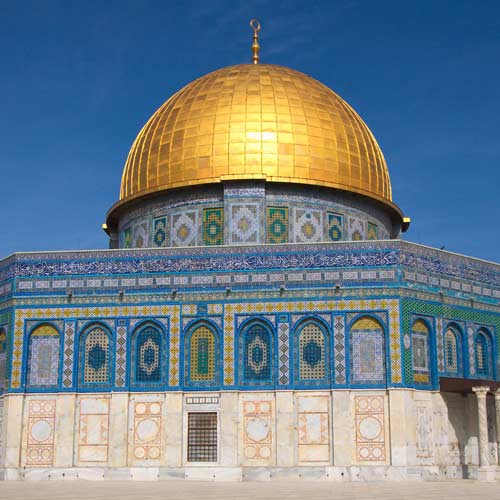
This temple was destroyed by the Romans in 70 AD, in fulfillment of Jesus’ words in Matthew 24:2: “There will not be left here one stone upon another that will not be thrown down.” On the Temple Mount now stands the Dome of the Rock. The Al Aqsa Mosque, also on the Temple Mount, is where Muslims gather to pray. As Todd Bolen notes, “Muslims believe that this is the place where Abraham nearly sacrificed his son Ishmael,” whereas Christians and Jews understand this son to have been Isaac (Gen. 22:2). “Muslims have sanctified this as the third most holy place in the Muslim world (after shrines in Mecca and Medina, both in Saudi Arabia).” This is why there is some tension over the site. Muslims have a 1300-year investment here, which must be respected in order to maintain peace. They do, however, graciously allow visitors to the site.
The Western Wall
Just west of the Temple Mount is the Western Wall, or Kotel, an Old City Jerusalem holy site which has great significance to the Jewish people because it is believed by many to have been one of the outer walls of the temple court. Once thought to have been completed by Herod the Great in the first century BC, the discovery of bronze coins under the foundation stones, in 2011, indicates that at least part of the wall wasn’t finished until almost 20 years after Herod’s death.
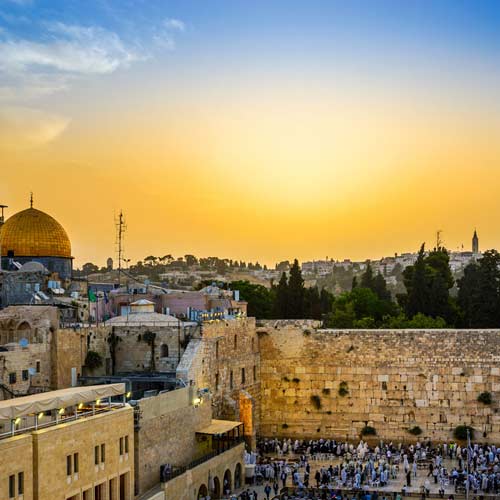
Jews come to this wall regularly to pray, tucking written prayers into the cracks between the stones of the wall. It remains one of the most popular Old City Jerusalem holy sites to visit, and during Jewish feast days, this area is alive with activity and singing. For example, the summer feast of Shavuot, (the Feast of Weeks) or Pentecost (from the Greek for 50), is celebrated here with joy and ardor seven weeks, or 50 days, after Passover, as prescribed in Leviticus 23:15-21.
According to Breaking Israel News, “when the Great Temple stood at the center of Jerusalem, the entire populace celebrated the summer agricultural festival of Shavuot, which was harmonized directly with the agricultural activities that were the mainstay of industry in the Land of Israel.”
The Shavuot holiday was celebrated in 2015 with all three of the major components of the holiday service, for the first time in nearly 2,000 years. “On a mountain ridge overlooking the Old City of Jerusalem and the ancient Temple Mount, kohanim (ancestral priests) performed a dry run of the Temple Service for the Shavuot (Pentecost) holiday– bringing of the first fruits, preparation of two loaves of bread using the season’s new wheat, and a special holiday offering. These rituals were conducted to as great a level of detail as is possible at this point in time.”
Many visitors come to Jerusalem to witness the observance of the Jewish feasts because of their prophetic significance. Living Passages often offers tours to Israel that coincide with these important feasts, so that you, too, can experience the celebration firsthand.
The Church of the Holy Sepulchre
The traditional sites of both the crucifixion and the tomb of Jesus are linked to the Church of the Holy Sepulchre, based on the account in John 19:41-42, which says that “in the place where he was crucified there was a garden, and in the garden a new tomb in which no one had yet been laid. So because of the Jewish day of Preparation, since the tomb was close at hand, they laid Jesus there.”
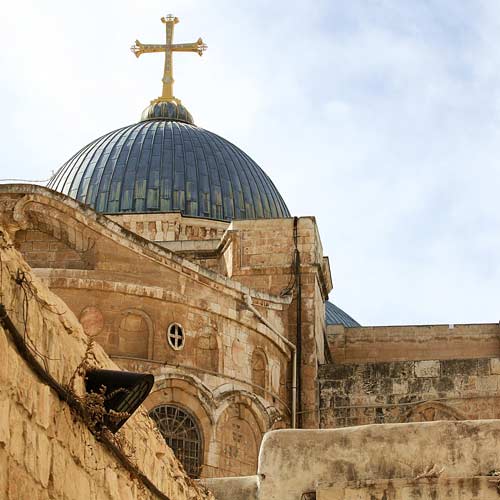
Jesus was crucified at “The Place of the Skull,” or Golgotha, in Aramaic. This has been associated with a stone quarry that existed outside of the city wall at that time. Later, another wall was built which enclosed the site within what we now consider to be the Old City. During the subsequent years of Roman rule over Jerusalem, a temple to Venus was erected at this location, but by Emperor Constantine’s Christian authority, this temple was destroyed. A tomb was discovered which was thought to be the tomb of Jesus, and a church was built at the site to memorialize it. In the wake of Byzantine, Muslim, and later Crusader destructions, reconstructions, and modifications, the church has a complex structure to match its history, but it is still one of the most popular sites in Jerusalem today.
The Garden Tomb
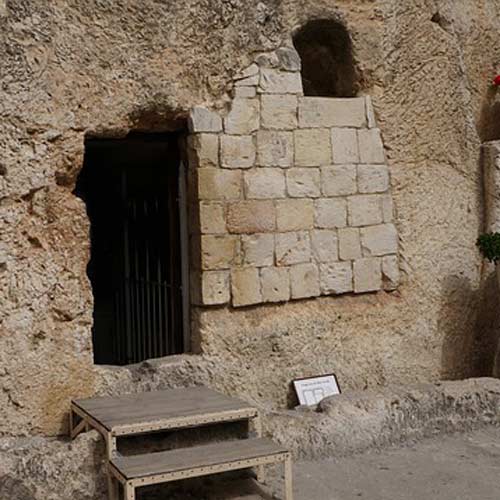
An alternate site of Jesus’ tomb is called the Garden Tomb. While in Jerusalem in 1883, General Charles Gordon noticed an outcropping of rocks which he thought looked like the “place of the skull” mentioned in the Bible. As Todd Bolen notes, “a previously discovered rock-hewn tomb was associated with the escarpment, and Gordon popularized the view that this was the actual place where Jesus was crucified and buried. The slope has eroded badly in the last hundred years, but some maintain they can still see the eye sockets and the nose bridge.”
Some argue that “the place of a skull” doesn’t demand that the place looks like a skull, and the tomb associated with these rocks wasn’t a “new tomb” in the first century, as John 19:41 demands. Others note that there is a large cistern nearby, which suggests that the area was a garden in Jesus’s day, and “that marks of Christian veneration at the tomb also prove its sanctity throughout the ages.”
Other sites have been proposed, as well, for both the crucifixion and burial. Scholars continue to consider possibilities that lie outside of man-made traditions when those traditions conflict with archaeology and with the Scripture.
The Mount of Olives Holy Sites
There are a number of important biblical events that occurred on the Mount of Olives. Jesus spent a great deal of time here, just across the Kidron Valley from Old City Jerusalem.
Bethany
His friends, Mary, Martha, and Lazarus lived in Bethany (Jn 11:1), which was on the Mount of Olives, about two miles east of Jerusalem (Jn 11:18), and Jesus is thought to have stayed in their home during His visits to Jerusalem. Early Christians held the events and places associated with Jesus’ life in great reverence, and passed their knowledge down through the generations. Many of these traditions were carried on until the time when Christianity became the state religion, and churches were built with no expense spared to memorialize these special places. According to the Lexham Bible Dictionary, archaeologists have excavated four ancient churches in Bethany, the earliest of which
“dates back to the fourth century and was built to honor the site where Jesus raised Lazarus from the dead.”
Michael S. Guyer, “Bethany on the Mount of Olives,” ed. John D. Barry et al., The Lexham Bible Dictionary (Bellingham, WA: Lexham Press, 2016).
The tomb of Lazarus can still be seen in Bethany,
“and the village’s modern-day name el-Azariah (“the place of Lazarus”) demonstrates the significance of this biblical event.”
Guyer, LBD.
The Triumphal Entry
Jesus’ Triumphal Entry into Jerusalem on a donkey (Matt. 21:1-11), just days before He died, led Him down the descent of the Mount of Olives along a steep, narrow road that now curves past the walls of ancient graveyards and near the Garden of Gethsemane. He then crossed the Kidron Valley to ascend to the temple that was standing in the first century (Matt. 21:12).
Garden of Gethsemane

According to the Israel Ministry of Foreign Affairs, “The name Gethsemane is a Greek form of the Hebrew gat shemanim ([olive] oil press).” Near the base of the Mount of Olives, just opposite the Temple Mount, there is a grove of gnarled olive trees, some of which are enormous and possibly nearly 2,000 years old. However, it is unlikely that these trees witnessed Jesus’ agonizing prayer to His Father, as recorded in Matthew 26:39-44. According to Todd Bolen, there was a report “that the Romans cut down all the trees in the area in their siege of Jerusalem in AD 70.” A Byzantine and a later Crusader church were built here to commemorate the site of Jesus’ prayer, betrayal, and arrest. The Church of All Nations, also called the Basilica of the Agony, which was built in 1924, currently marks this important site.
Site of the Ascension
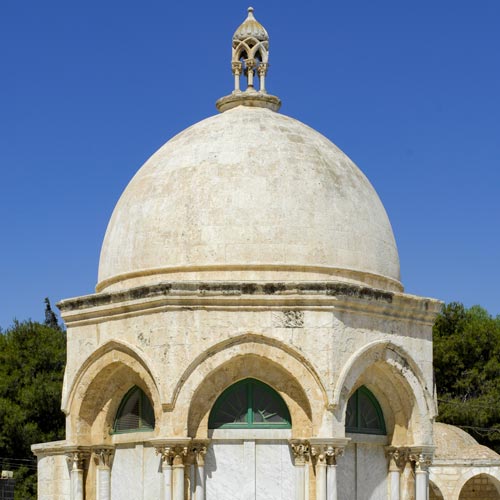
We read about Jesus’ ascension to heaven in Luke 24:50-51: “And he led them out as far as Bethany, and lifting up his hands he blessed them. While he blessed them, he parted from them and was carried up into heaven.”
There are several Jerusalem holy sites that are associated with the Ascension. One is the Paternoster Church, a Roman Catholic church that is built next to the site of the 4th century Church of Eleona (Greek for of olives),
under which is a cave where Jesus is believed to have taught his disciples.
Jerome Murphy-O’Connor, The Holy Land: An Oxford Archaeological Guide from Earliest Times to 1700 (Oxford: Oxford University Press, 2008),
The Russian Ascension Church was built in the late 19th century and boasts a tall, square tower and two Armenian mosaics from the Byzantine period. In addition, it is believed to be the resting place of the head of John the Baptist.
Murphy-O’Connor.
The Dome of the Ascension, which houses footprints believed to belong to Jesus, was converted into a mosque by Saladin in 1187 and it remains a Muslim shrine to this day.
Future Site of His Return
While we may not know the exact location of Jesus’ ascension, as noted above, Scripture indicates that He ascended into heaven in the vicinity of Bethany. Some believe he will return to the same place He left, based on Acts 1:10-11: “And while they were gazing into heaven as he went, behold, two men stood by them in white robes, and said, “Men of Galilee, why do you stand looking into heaven? This Jesus, who was taken up from you into heaven, will come in the same way as you saw him go into heaven.” We also know that Jesus will return to the Mount of Olives, based on Zechariah 14:4, which says, “On that day his feet shall stand on the Mount of Olives that lies before Jerusalem on the east, and the Mount of Olives shall be split in two from east to west by a very wide valley, so that one half of the Mount shall move northward, and the other half southward.”
One of the most exciting aspects of walking in the footsteps of Jesus is the certainty the Bible provides that He will return. In all of our travels throughout Jerusalem holy sites and elsewhere in Israel, we are reminded that we do not worship a dead man. The grave is empty, Christ is risen, has ascended to the right hand of the Father, and He will return in victory to restore righteousness to the earth. Join us for a tour of Israel, and experience the Bible for yourself!


